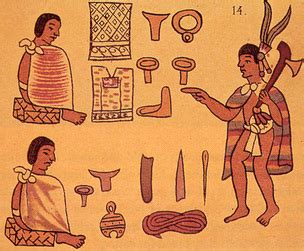The Untold Story of Aztec Trade and Tribute: A Complex System of Power and Exchange
The Aztec Empire, a civilization that flourished in present-day Mexico from the 14th to the 16th centuries, is often portrayed through the lens of conquest and sacrifice. However, a deeper understanding reveals a sophisticated economic system built upon a complex interplay of trade and tribute, far more nuanced than often depicted. This intricate network was not merely a tool for extraction but a crucial element in maintaining social order, political stability, and the empire's remarkable growth.
What was the Aztec Tribute System?
The Aztec tribute system was a crucial aspect of their imperial power. Conquered provinces were required to deliver regular payments to the Aztec rulers in the form of goods and services. These payments weren't simply arbitrary demands; they were carefully calculated based on a province's capacity and resources. This system wasn't uniformly applied; the demands varied considerably depending on factors such as population size, geographic location, and the political importance of the province. Some areas paid heavily, while others provided more specialized goods or labor.
What goods and services were commonly part of the Aztec tribute?
The goods collected as tribute were incredibly diverse, reflecting the rich variety of resources within the Aztec empire. Common items included:
- Agricultural products: Maize (corn), beans, squash, chili peppers, cotton, cacao beans (used to make chocolate), and various fruits were staples.
- Textiles: Fine cotton and other fiber cloths, often intricately woven, were highly valued.
- Precious metals: Gold, silver, and copper were used in jewelry, tools, and religious objects.
- Obsidian: This volcanic glass was used for tools, weapons, and ceremonial objects. It was a vital trade item itself.
- Feathers: Certain brightly colored feathers, particularly those of quetzals, were extremely valuable for adornment and ritual purposes.
- Slaves: Though not as central as often portrayed, enslaved people were sometimes part of tribute payments.
- Labor: Skilled artisans and laborers were sometimes required to work on Aztec projects.
This diverse range of tribute showcases not just the empire's vast resources, but also its highly structured system for managing them.
Beyond Tribute: The Importance of Aztec Trade
While tribute formed a significant part of the Aztec economy, it wasn't the only mechanism of economic exchange. A vibrant system of trade existed, connecting different parts of the empire and beyond. Marketplaces, known as tianquiztli, were central hubs of economic activity, bustling with merchants exchanging a wide range of goods.
How did the Aztec trade system function?
Aztec trade relied on a sophisticated network of land and water routes. Canoes transported goods along rivers and lakes, while porters carried goods overland using established trails. The importance of trade routes is reflected in the construction of causeways and canals. Specialized merchants, known as pochteca, traveled extensively, facilitating trade both within the empire and with far-flung regions. These merchants often acted as spies and diplomats, gathering crucial intelligence for the Aztec rulers.
What were some of the key traded goods?
The pochteca traded a wide array of goods, including:
- Luxury items: Exotic feathers, cacao, jade, and other precious objects were exchanged for high prices.
- Everyday goods: Pottery, tools, textiles, and other essential goods were also traded widely.
- Raw materials: Obsidian, salt, and other materials were vital resources traded across great distances.
The extensive trade network was essential for distributing goods, ensuring access to resources not available locally, and facilitating economic growth within the empire.
How did Tribute and Trade Interrelate?
Tribute and trade weren't mutually exclusive; they were intertwined parts of the Aztec economic system. Tribute payments often consisted of goods that were themselves traded, highlighting the seamless integration of the two systems. Provinces might contribute tribute in the form of goods they specialized in producing, which would then be further traded within the empire or with other regions. This created a dynamic system where the flow of goods was constantly shifting, reinforcing both the political power of the Aztec state and the economic vitality of the empire.
The Impact of European Contact
The arrival of the Spanish conquistadors dramatically altered the Aztec system. The Spanish destroyed the existing infrastructure, redirected trade routes, and disrupted the balance of power, ultimately leading to the collapse of the empire. However, the legacy of the sophisticated Aztec system of trade and tribute remains a testament to their organizational capacity and economic ingenuity. Understanding this system is crucial for comprehending the complexities of the Aztec civilization beyond the simplified narratives of conquest and sacrifice.

